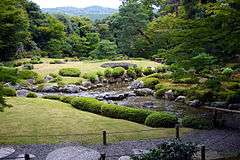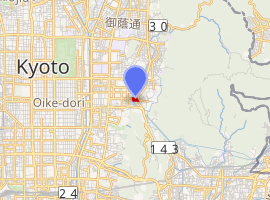Murin-an
Murin-an (無鄰菴) is a Japanese garden in Kyoto, built by political and military leader Gensui Prince Yamagata Aritomo between 1894 and 1898. It is an example of a classical Japanese promenade garden of the Meiji Period.
| Murin-an | |
|---|---|
| Murin-an (無鄰菴) | |
 Garden of Murin-an with the Higashiyama in the background | |

| |
| Type | Japanese garden |
| Location | Kyoto, Japan |
| Coordinates | 35°00′42″N 135°47′14″E |
| Created | 1894 |
History
Gensui Prince Yamagata Aritomo (1838-1922) was an important figure in the politics and military affairs of the Meiji Period. Born into an old samurai family and devoted to military affairs, he traveled to Europe in 1869 as part of a delegation of experts to study the Prussian Army, and when he returned he helped re-organize the Imperial Japanese Army on the Prussian model. He became Minister of War in 1873, and was twice Prime Minister of Japan, from 1889 to 1891 and from 1898 to 1900.
The completion of a canal between Lake Biwa and Kyoto provided a plentiful source of water for the area around the Nanzen-ji temple domain in Kyoto.[1] Yamagata, who was a great lover of gardens, purchased land in the area and made plans to build a villa and garden using water from the canal. The then Count Yamagata (he was elevated in the Kazoku to being a Marquis in August 1895, and a Prince in September 1907) began work in 1894, but stopped in 1895 to conduct a war with China. The Marquis Yamagata, as he was by this stage, resumed work when the war was finished, with the help of the notable garden designer Ogawa Jihei (1860-1933), also known as Ueji, who had built the garden of the recreated Kyoto Imperial Palace nearby.[2] In addition to the garden, he built a tea house, a traditional Japanese house, and a modern western-style house, complete with a lawn in the English style, added in 1898.[3]
Description
The garden is sited on the slopes of the Higashiyama Hills, and has a source of water by a canal from Lake Biwa, the largest lake in Japan, which feeds a shallow artificial stream, with a triple waterfall which runs through the garden. The garden covers 3135 square meters[4] and features contrasts between shady forests and sunlit open spaces, and a long promenade to see the different sights of the garden, including many views of the Higashiyama Hills.[5]
- Garden path in Murin-an
- Corner of the residence in Murin-an
- Residence in Murin-an
- Teahouse at Murin-an
- Garden view with bridge in Murin-an
References
- Mansfield. Page 35.
- Mansfield. Page 35.
- Elisseeff. Pages 106-109.
- Mansfield. Page 35.
- Elisseeff. Pages 106-109.
Bibliography
- Elisseeff, Danielle (2010). Jardins Japonais. Paris: Nouvelles Editions Scala. ISBN 978-2-35988-029-8.
- Mansfield, Stephen (2011). Japan's Master Gardens - Lessons in Space and Environment (Hardback). Tokyo, Rutland, Singapore: Tuttle. ISBN 978-4-8053-1128-8.
External links
![]()
- Murin-an official website (in English)
- Kyoto City information page (in Japanese)